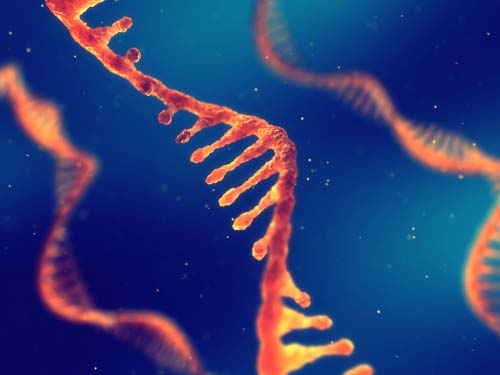Nucleic Acids - RNA
The protein builder
In all living things, ribonucleic acid (RNA) is the carrier of genetic information it receives from its biomolecular cousin, deoxyribonucleic acid (DNA). RNA, however, is the molecule that puts this information into practice. In concert with cellular ribosomes and amino acids, RNA translates the genetic code it receives from DNA and, through a process called translation, synthesizes the enormous gamut of proteins an organism needs to live.
Each single-stranded RNA molecule (as opposed to the two-stranded DNA double-helix) is a chainlike structure made from a sequence of nucleotides, each consisting of a nitrogenous base unit, a pentose sugar and a phosphate group that bridges one nucleotide to another. RNA uses four nucleobases arranged in a sequence that carries genetic information:
- Adenine (A)
- Guanine (G)
- Cytosine (C)
- Uracil (U) — which replaces the thymine (T) found in DNA
Types of RNA
RNA comes in many forms with varying functions, but three major types instrumental to protein synthesis in all organisms have been most thoroughly studied:
- Messenger RNA (mRNA) is synthesized from DNA in the nucleus and enters the surrounding cytoplasm where it can interact with cellular ribosomes to begin the process of protein synthesis.
- Ribosomal RNA (rRNA) is attached to two existing protein subunits to form a complete ribosome, which moves along an mRNA strand identifying each three-nucleotide sequence as corresponding to a specific amino acid.
- Transfer RNA (tRNA) is a short RNA segment that interacts with the ribosome/mRNA complex and incorporates the correct amino acid into a growing chain that will become a complete, newly synthesized protein.
Numerous other less commonly researched RNA types have been identified and characterized, including micro RNA (miRNA): tiny nucleic acid chains that act as gene regulators in most eukaryotic organisms. Micro RNAs can bind to mRNA fragments with complementary base sequences, preventing the translation and synthesis of specific proteins.
RNA-associated diseases
Micro RNA can affect disease-related genes in the way described, either promoting or inhibiting the emergence and growth of certain tumors. Other disease states linked to dysfunction of miRNA or other RNA types include:
- Alzheimer's disease and other neurodegenerative disorders
- Cancers caused by inhibition of apoptosis (programmed cell death)
- Amyotrophic lateral sclerosis (ALS)
- Myotonic dystrophy
Current approved and experimental "RNA therapy" approaches include using miRNA to degrade dysfunctional proteins (applied to hemophilia treatment), as well as mRNA replacement (cystic fibrosis). As more and stronger links between RNA and disease states are discovered, research continues into existing and potential paths toward prevention and treatment.

